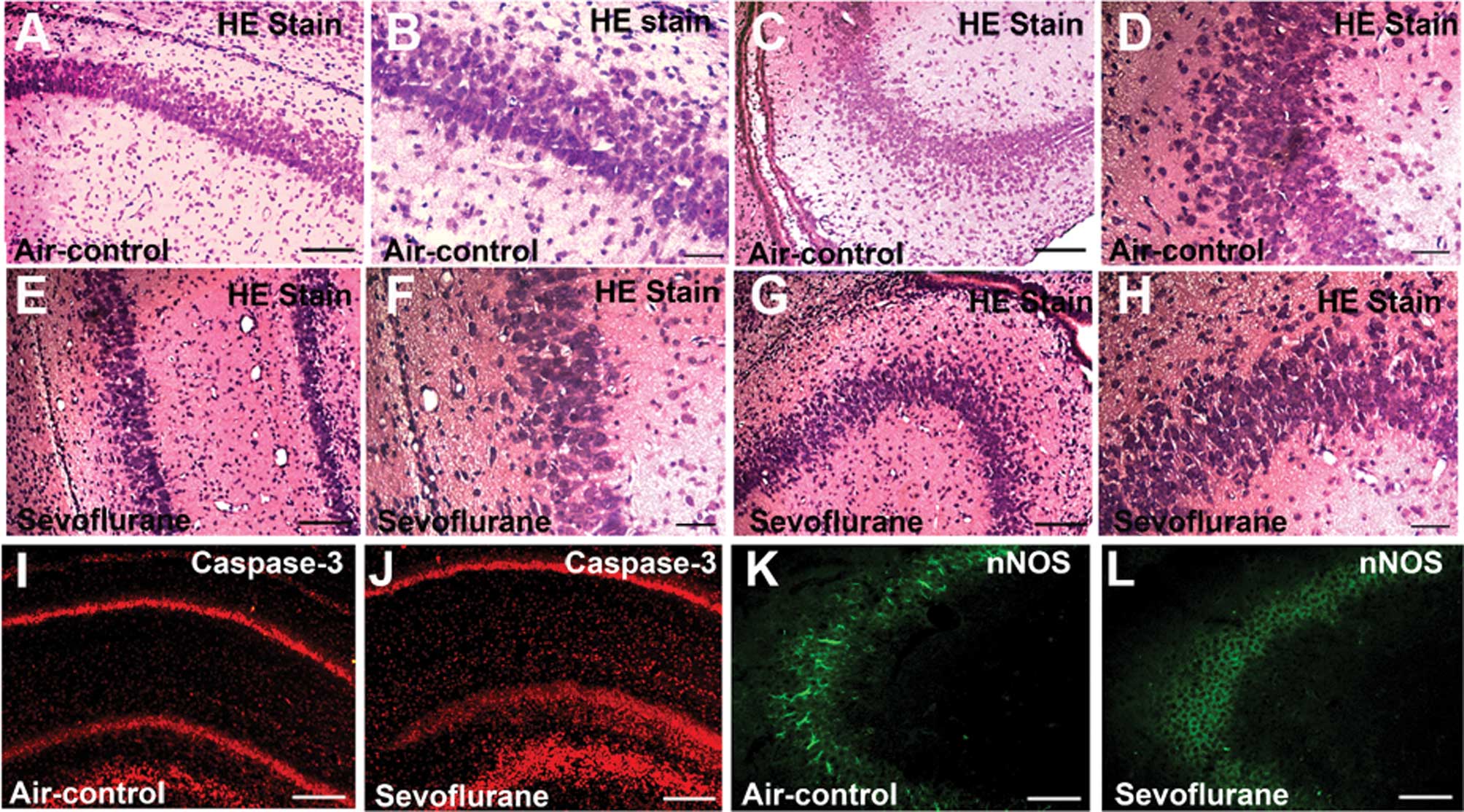|
1
|
Anand KJ: Anesthetic neurotoxicity in
newborns: should we change clinical practice? Anesthesiology.
107:2–4. 2007. View Article : Google Scholar : PubMed/NCBI
|
|
2
|
Wiklund A, Granon S, Faure P, Sundman E,
Changeux JP and Eriksson LI: Object memory in young and aged mice
after sevoflurane anaesthesia. Neuroreport. 20:1419–1423. 2009.
View Article : Google Scholar : PubMed/NCBI
|
|
3
|
Jevtovic-Todorovic V, Hartman RE, Izumi Y,
et al: Early exposure to common anesthetic agents causes widespread
neurodegeneration in the developing rat brain and persistent
learning deficits. J Neurosci. 23:876–882. 2003.
|
|
4
|
Perouansky M: General anesthetics and
long-term neurotoxicity. Handb Exp Pharmacol. 182:143–157. 2008.
View Article : Google Scholar : PubMed/NCBI
|
|
5
|
Lerman J, Sikich N, Kleinman S and Yentis
S: The pharmacology of sevoflurane in infants and children.
Anesthesiology. 80:814–824. 1994. View Article : Google Scholar : PubMed/NCBI
|
|
6
|
Shelton KL: Discriminative stimulus
effects of inhaled 1,1,1-trichloroethane in mice: comparison to
other hydrocarbon vapors and volatile anesthetics.
Psychopharmacology (Berl). 203:431–440. 2009. View Article : Google Scholar : PubMed/NCBI
|
|
7
|
Nishikawa K and Harrison NL: The actions
of sevoflurane and desflurane on the gamma-aminobutyric acid
receptor type A: effects of TM2 mutations in the alpha and beta
subunits. Anesthesiology. 99:678–684. 2003. View Article : Google Scholar : PubMed/NCBI
|
|
8
|
Kvolik S, Dobrosevic B, Marczi S, Prlic L
and Glavas-Obrovac L: Different apoptosis ratios and gene
expressions in two human cell lines after sevoflurane anaesthesia.
Acta Anaesthesiol Scand. 53:1192–1199. 2009. View Article : Google Scholar : PubMed/NCBI
|
|
9
|
Dong Y, Zhang G, Zhang B, Moir RD, Xia W,
Marcantonio ER, Culley DJ, Crosby G, Tanzi RE and Xie Z: The common
inhalational anesthetic sevoflurane induces apoptosis and increases
beta-amyloid protein levels. Arch Neurol. 66:620–631.
2009.PubMed/NCBI
|
|
10
|
Porro A, Chrochemore C, Cambuli F, Iraci
N, Contestabile A and Perini G: Nitric oxide control of MYCN
expression and multi drug resistance genes in tumours of neural
origin. Curr Pharm Des. 16:431–439. 2010. View Article : Google Scholar : PubMed/NCBI
|
|
11
|
Hsu YY, Liu CM, Tsai HH, Jong YJ, Chen IJ
and Lo YC: KMUP-1 attenuates serum deprivation-induced
neurotoxicity in SH-SY5Y cells: roles of PKG, PI3K/Akt and
Bcl-2/Bax pathways. Toxicology. 268:46–54. 2010. View Article : Google Scholar : PubMed/NCBI
|
|
12
|
Ciani E, Guidi S, Della Valle G, Perini G,
Bartesaghi R and Contestabile A: Nitric oxide protects
neuroblastoma cells from apoptosis induced by serum deprivation
through cAMP-response element-binding protein (CREB) activation. J
Biol Chem. 277:49896–49902. 2002. View Article : Google Scholar
|
|
13
|
Iwase K, Takemura M, Shimada T, Wakisaka
S, Nokubi T and Shigenaga Y: Ontogeny of NADPH-diaphorase in rat
forebrain and midbrain. Anat Embryol (Berl). 197:229–247. 1998.
View Article : Google Scholar : PubMed/NCBI
|
|
14
|
Porter AG and Janicke RU: Emerging roles
of caspase-3 in apoptosis. Cell Death Differ. 6:99–104. 1999.
View Article : Google Scholar : PubMed/NCBI
|
|
15
|
Woo M, Hakem R, Soengas MS, Duncan GS,
Shahinian A, Kägi D, Hakem A, McCurrach M, Khoo W, Kaufman SA, et
al: Essential contribution of caspase 3/CPP32 to apoptosis and its
associated nuclear changes. Genes Dev. 12:806–819. 1998. View Article : Google Scholar : PubMed/NCBI
|
|
16
|
Hirata H, Takahashi A, Kobayashi S,
Yonehara S, Sawai H, Okazaki T, Yamamoto K and Sasada M: Caspases
are activated in a branched protease cascade and control distinct
downstream processes in Fas-induced apoptosis. J Exp Med.
187:587–600. 1998. View Article : Google Scholar : PubMed/NCBI
|
|
17
|
Janicke RU, Sprengart ML, Wati MR and
Porter AG: Caspase-3 is required for DNA fragmentation and
morphological changes associated with apoptosis. J Biol Chem.
273:9357–9360. 1998. View Article : Google Scholar : PubMed/NCBI
|
|
18
|
Satomoto M, Satoh Y, Terui K, Miyao H,
Takishima K, Ito M and Imaki J: Neonatal exposure to sevoflurane
induces abnormal social behaviors and deficits in fear conditioning
in mice. Anesthesiology. 110:628–637. 2009. View Article : Google Scholar
|
|
19
|
Win-Shwe TT, Yoshida Y, Kunugita N,
Tsukahara S and Fujimaki H: Does early life toluene exposure alter
the expression of NMDA receptor subunits and signal transduction
pathway in infant mouse hippocampus? Neurotoxicology. 31:647–653.
2010. View Article : Google Scholar : PubMed/NCBI
|
|
20
|
Young C, Roth KA, Klocke BJ, West T,
Holtzman DM, Labruyere J, Qin YQ, Dikranian K and Olney JW: Role of
caspase-3 in ethanol-induced developmental neurodegeneration.
Neurobiol Dis. 20:608–614. 2005. View Article : Google Scholar : PubMed/NCBI
|
|
21
|
Knott AB and Bossy-Wetzel E: Nitric oxide
in health and disease of the nervous system. Antioxid Redox Signal.
11:541–554. 2009. View Article : Google Scholar : PubMed/NCBI
|
|
22
|
Garthwaite J: Concepts of neural nitric
oxide-mediated transmission. Eur J Neurosci. 27:2783–2802. 2008.
View Article : Google Scholar : PubMed/NCBI
|










